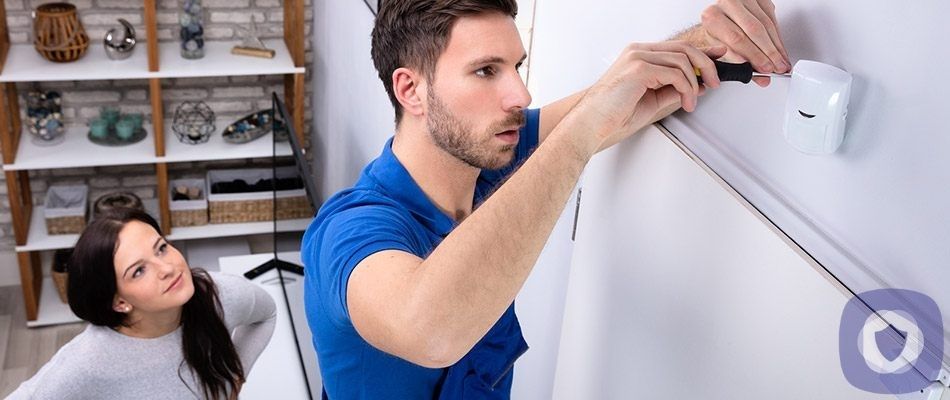A motion detector is the first line of defense in home security. Put simply: Motion detectors sense if someone is entering an area of your home and respond to that intrusion. By placing a motion sensor near a door or hallway, you’ll be able to know if someone is in your house, driveway or yard when they shouldn’t be. This guide will help you decide what type of motion sensor is best for your space.
Reasons to invest in a motion sensor:
- Motion detection alerts you if window or door is entered.
- Notifies you if a thief enters your home while away.
- Lets you know if someone is at your front door.
- Outdoor motion sensors save electricity by only turning on when someone is outside.
- Helps give you peace of mind.
Types of motion detectors for your space
There are multiple different technologies to choose from when deciding which motion sensors to install in your home. Think about the layout of your home and its general environment before deciding which technology will work best for your security setup. Below are the different types of motion sensors that you can choose from for your home.
1. Active Sensors
Active sensors use signals (such as radar waves or sound waves) to detect any changes in an area. These are the common types of active sensors:
- Ultrasonic: This is the most commonly used type when it comes to lighting motion detectors. It works by emitting high-frequency sound waves. If there are any changes in the sound wave pattern, it triggers the motion detector.
- Microwave: This is used in most home security systems. It emits electromagnetic radiation which detects movement. These types of sensors emit waves that bounce back to the receiver. If those waves are disrupted by movement, the microwave sensor will be able to detect it and set off an alarm.
- Tomographic: This type of motion sensor uses radio waves, and covers larger spaces. Any change in the radio wave pattern triggers the motion detector.
- Area reflective: This technology uses LED lights that send out infrared rays. Area reflective sensors use the reflection of the infrared rays to identify if an object has entered a designated space.
2. Passive Sensors
A Passive Infrared motion sensor (PIR) operates by detecting body heat. If a person or animal passes through the designated area, the sensors will detect the change in temperature and alert you of movement. It’s important to place these sensors in the correct area because of their sensitivity to heat. Installing them close to a heat source or a drafty area could cause false alarms.
3. Dual Technology Sensors
This type of motion detector utilizes more than one of these technologies to get the job done. They use both ultrasonic and PIR technology and are a good fit for commercial spaces. This can effectively reduce false alarms because both technologies would have to trip in order for you to be notified.
Special features to look for in motion sensors
You can purchase a basic motion detector or look for models with more features — usually aimed at reducing false alarms or making installation easier. Here are some features to consider when choosing your motion detector.
- Wireless motion sensors
- Choosing a wireless model will make your life easier from start to finish. No wires means no drilling and a simpler setup. This type of motion sensor will communicate with your home security system wirelessly and these are the most common type of sensor used today.
- Contact sensitive motion sensors
- These types of sensors are installed on doors and windows are typically passive infrared sensors. They will trigger your security alarm immediately if a door or window is opened in your home.
- Pet immune sensors
- Pet owners are never quite sure what animals are up to while they’re away at work. But if you have an active dog or cat, it’s possible a motion sensor would be activated due to their movements. There are some passive sensors that can be set to ignore your pet’s movements. You can usually set them up to ignore animals up to a certain weight, which means they should still be useful for protecting your home from unwanted human intruders.
- Sensors with video capability
- Some motion detectors work hand-in-hand with video security systems. Using this technology, the camera will only record when the sensor is tripped. This saves on memory for your security camera and, of course, it can come in handy to have video evidence of a break-in.
How to properly install your motion detectors
If you’ve gone with a professional home security system, you likely won’t have to worry much about where your sensors are mounted since they’ll either do the setup for you or guide you in doing it yourself. But if you’re skipping hiring the pros and doing everything yourself, make sure you understand how to properly place them in and around your home. Here are some easy tips to make sure you aren’t causing false alarms or missing important areas.
- Install PIR sensors at 10-15 feet away from heat sources. Placing a motion sensor near heating vents could trip the sensor. Also pay close attention to whether your sensor will be in sunlight. You don’t want the sensor to be activated based on time of day.
- Avoid drafty areas in your home. If you notice a certain hallway gets blasts of cold air from the air conditioner, that may not be an ideal place to add a motion sensor. A sudden change in temperature from a drafty area could trigger your sensor.
- Install sensors where burglars would pass through. Thieves generally enter through front and back doors or through the garage. Install your motion sensors near the points of entry and even in hallways where you know a burglar would have to pass through to gain entry into your home. Do a walk through of your home from the point of view of an intruder before you decide where to place your motion detector.
- Test motion sensors before putting them to use. Figure out if you’ve placed sensors in the correct area by testing them. Arm your system and test to see if the sensors are activated as expected when you pass through. Try to pass through areas undetected to see if you have any security blind spots.
- Clean motion sensors regularly. This is especially true for outside motion sensors since they are more prone to dirt and dust particles. Any debris on the sensor could keep it from detecting motion.
There are multiple types of motion sensor technologies to choose from. Knowing your space and environment is important to not only choosing the right sensor for your home, but also matters when you’re determining where to place them throughout your living area. Motion sensors are a crucial part of your home security system and can even save on energy costs. Don’t skip out on purchasing one or more of these workhorses!
Motion detector FAQs
The level of movement needed to set off a motion detector will vary from camera to camera. Some are equipped with advanced tech that allows movement of pets to be ignored, as one example. (More on that here.)
For maximum effectiveness, place your motion sensors in spots that provide a clear line of sight to all the main entrances (like the font and back doors, as well as a garage door if you have one) as well as the main hallways. If you have a multi-floor home, make sure the stairs are covered, as this is a likely path of travel.
This depends completely on the model. Some security cameras have motion detection tied to automatic recording, while others are "always on". Check out our reviews of the best security cameras to see what fits your personal needs.
This article has been reviewed and approved by Officer Banta.

Officer Banta is the official SecurityNerd home security and safety expert. A member of the Biloxi Police Department for over 24 years, Officer Banta reviews all articles before lending his stamp of approval. Click here for more information on Officer Banta and the rest of our team.

